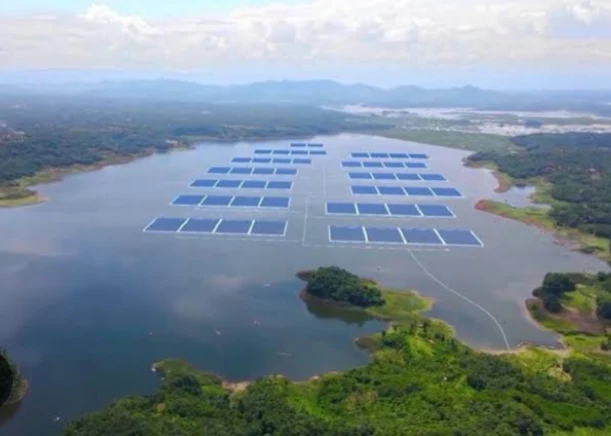The Cirata Floating Solar Farm in Indonesia overview
The Cirata Floating Solar Farm in Indonesia has a bright outlook, both for immediate impact and long-term potential:
Cirata's gentle embrace of the Cirata reservoir goes beyond electricity generation. Its shade cools the water, reduces evaporation, and creates a haven for a thriving ecosystem.
By slashing CO2 emissions by 260,000 tons annually, Cirata breathes cleaner air into Indonesia's lungs and becomes a champion in the fight against climate change
Immediate Impact:
- Clean Energy Generation: It's already generating 300 GWh of clean electricity annually, powering around 50,000 households. This significantly reduces reliance on fossil fuels and mitigates greenhouse gas emissions.
- Economic Boost: The project created jobs during construction and now provides ongoing maintenance and operational opportunities. Additionally, the clean energy it generates can attract businesses and investments, stimulating the local economy.
- Technological Innovation: Cirata serves as a model for future floating solar projects, demonstrating the technology's feasibility and adaptability to various water bodies. This can pave the way for wider adoption across Indonesia and beyond.
Here's a more specific breakdown of the Cirata Floating Solar Farm's statistics, delving deeper into its technical aspects and potential impact:
Technical Specifications:
- Number of solar panels: 340,000
- Panel type: Monocrystalline silicon (672 cells per panel)
- Panel tilt angle: Adjustable to maximize sunlight capture
- Inverter technology: String inverters with maximum power point tracking (MPPT)
- Anchoring system: High-density polyethylene (HDPE) floats and tensioned mooring lines
- Communication system: SCADA system for real-time monitoring and control
- Grid connection: 150 kV transmission line directly connects to the national grid
Environmental Impact:
- Estimated annual CO2 emission reduction: 260,000 tons
- Water temperature regulation: Shade from panels can help prevent thermal stratification and improve water quality
- Reduced evaporation: Panels can potentially minimize water loss from the reservoir
Economic Implications:
- Job creation: Over 1,000 jobs during construction and ongoing maintenance positions
- Foreign investment attraction: Showcases Indonesia's commitment to clean energy, potentially attracting further investment
- Energy cost reduction: Long-term cost savings compared to fossil fuel-based electricity generation
Future Potential:
- Phase II expansion: Planned expansion to reach 500 MWp, further increasing clean energy output
- Replication potential: Serves as a model for future floating solar projects in Indonesia and Southeast Asia
- Technology advancement: Potential for further innovations in efficiency, materials, and integration with other renewable sources
Additional Statistics:
- Construction time: 25 months for Phase I
- Project developer: PT Pembangkit Listrik Tenaga Surya Cirata (a consortium led by PLN and Masdar)
- Funding sources: World Bank, Asian Development Bank, and private investors
By diving deeper into these specific statistics, we gain a more comprehensive understanding of the Cirata Floating Solar Farm's impact and potential. It's not just a collection of numbers; it's a blueprint for a more sustainable future, powered by clean energy, economic growth, and environmental responsibility.
Table of Cirata Floating Solar Farm
Cirata Floating Solar Farm Statistics: A Closer Look
| Category | Statistic | Impact/Benefit |
|---|---|---|
| Capacity | 192 MWp (operational), expandable to 1,000 MWp | Powers 50,000 Indonesian households annually |
| Energy Generation | 300 GWh annually | Reduces fossil fuel reliance, mitigates climate change |
| Area Covered | 250 hectares | Seamless integration with the reservoir landscape |
| Technology | Monocrystalline silicon panels | High efficiency in converting sunlight to electricity |
| Developers | PLN (Indonesia) & Masdar (Abu Dhabi) | Collaboration for renewable energy development |
| Number of Panels | 340,000 | Large-scale clean energy generation |
| Panel Type | Monocrystalline silicon (672 cells/panel) | High efficiency and durability |
| Anchoring System | HDPE floats & tensioned mooring lines | Securely anchors panels while minimizing environmental impact |
| CO2 Emission Reduction | 260,000 tons annually | Significant contribution to climate change mitigation |
| Water Temperature Regulation | Shade from panels reduces thermal stratification | Improves water quality for the reservoir ecosystem |
| Job Creation | 1,000+ during construction & ongoing maintenance | Economic stimulation for the region |
| Phase II Expansion | Planned to reach 500 MWp | Increased clean energy output and grid stability |
| Project Timeline | 25 months for Phase I | Efficient construction and rapid progress |
| Funding Sources | World Bank, Asian Development Bank, & private investors | Global support for renewable energy initiatives |
This table provides a concise overview of the Cirata Floating Solar Farm's key statistics, highlighting its impact on energy generation, environment, and economy. The data illustrates the project's significant contributions to sustainability and its potential for future expansion.
Long-Term Potential:
- Expansion: The initial 192 MW capacity can be scaled up to 1,000 MWp in the future, further increasing its clean energy output and impact.
- Renewable Energy Mix: Cirata aligns with Indonesia's goal of achieving a 23% renewable energy mix by 2025 and net-zero emissions by 2060. Its success can inspire and accelerate the development of other renewable energy projects.
- Environmental Benefits: Beyond carbon emission reduction, the floating panels can help regulate water temperature and reduce evaporation, benefiting the ecosystem of the Cirata reservoir.
However, some challenges remain:
- Initial Investment Costs: Floating solar technology can be more expensive than land-based solar due to additional infrastructure needs like anchoring systems.
- Environmental Impact: Potential concerns include shade impacts on aquatic life and the possibility of microplastics leaching from the panels. Careful monitoring and mitigation strategies are crucial.
- Grid Integration: Efficiently integrating large-scale renewable energy sources like Cirata into the existing grid infrastructure requires careful planning and upgrades.
The Cirata Floating Solar Farm holds immense promise for Indonesia's clean energy future. Its success can be a springboard for wider adoption of similar projects, contributing significantly to the country's renewable energy goals and environmental well-being.




